#bauhaus essentials
Photo

Le Corbusier (Charles-Edouard Jeanneret, dit), Pierre Jeanneret, Charlotte Perriand
Chaise longue B 306
#le corbusier#charlotte perriand#pierre jeanneret#centre pompidou#chaise longue#mininimalism#minimalist#minimalist style#bauhaus design#bauhaus essentials#bauhaus movement#bauhaus furniture#modern architecture
372 notes
·
View notes
Text
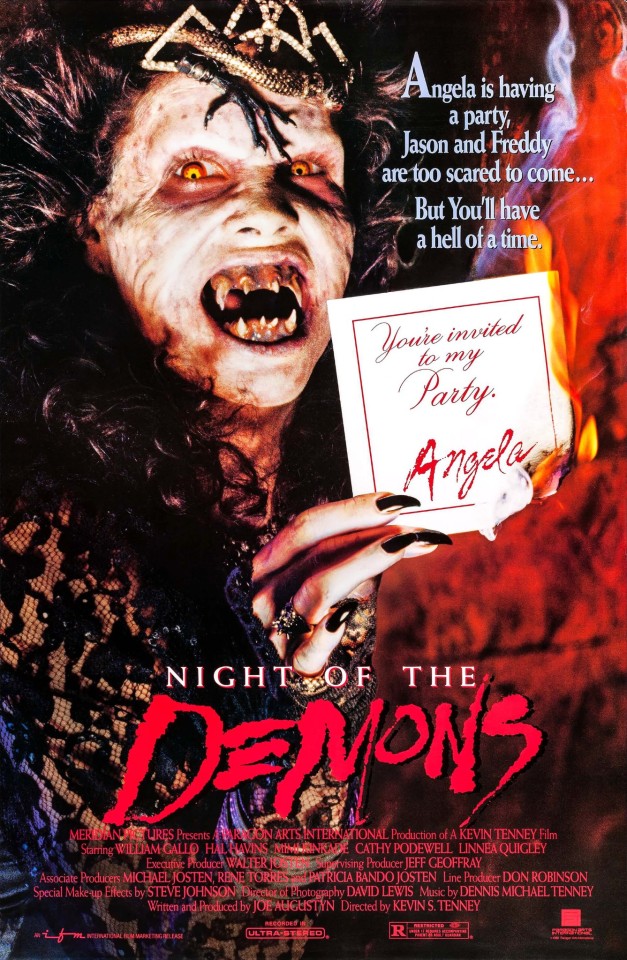
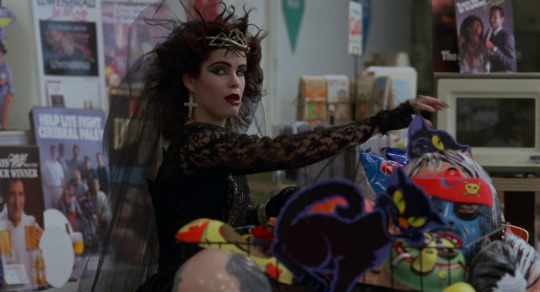
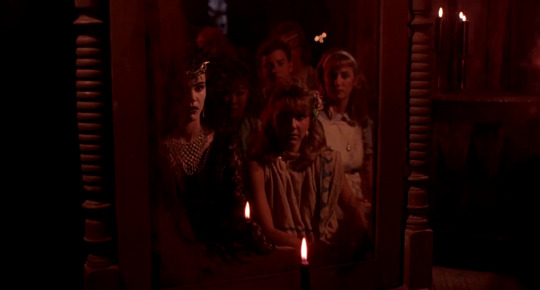



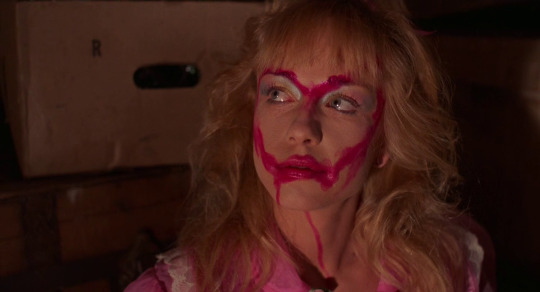
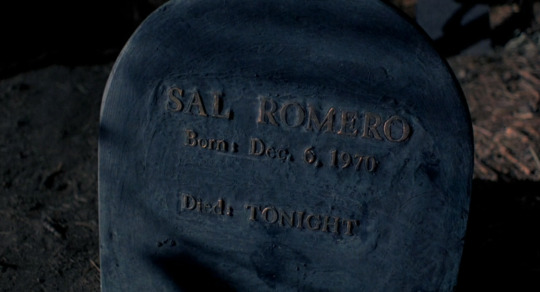
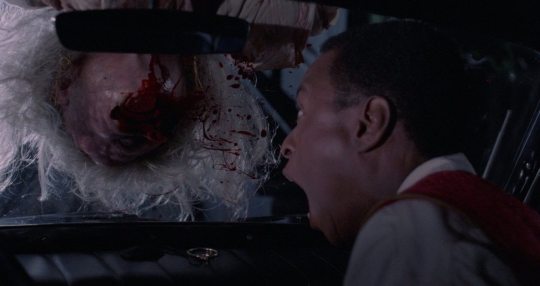
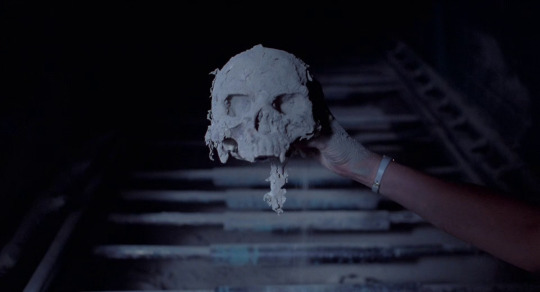
Night of the Demons (1988)
"Do you guys have sour balls?"
"Why, sure we do."
"Too bad, I bet you don't get many blowjobs."
#night of the demons#horror imagery#gore tw#1988#american cinema#horror film#kevin tenney#joe augustyn#cathy podewell#alvin alexis#billy gallo#linnea quigley#amelia kinkade#jill terashita#allison barron#hal havins#harold ayer#lance fenton#donnie jeffcoat#philip tanzini#karen ericson#late to this one ofc as I'm late to many of the horror classics. tried to watch this back in my uni days but i accidentally ended up#watching the 2009 remake (very meh). finally getting to this and i think it deserves the hype! a genuinely witty script full of#zingers‚ an iconic Lin Quigley appearance (second only to Return of the Living Dead for epoch defining Quigley moments) and a brilliant#performance from Kinkaid as the possessed party pooper (her frantic dance scene to a Bauhaus bop is‚ without hyperbole‚ a transcendent#moment in 80s horror and one of The scenes of all time). also ends on a bravura bit of irreverent silliness and has a pretty awesome#soundtrack to boot. I'm unexpectedly all in for this one! far outdid my expectations and made me intrigued for the (presumably awful)#sequels.#an undeniably essential part of the late 80s cheapo dtv horror canon
2 notes
·
View notes
Photo

家庭
#masayuki kojima#anime#manga#muji#bauhaus#television#mood du jour#mood#minimalism#minimalist#cartoon#japandi#japan#french style#the kooples#essential homme#parisian style#parisian vibe
19 notes
·
View notes
Text


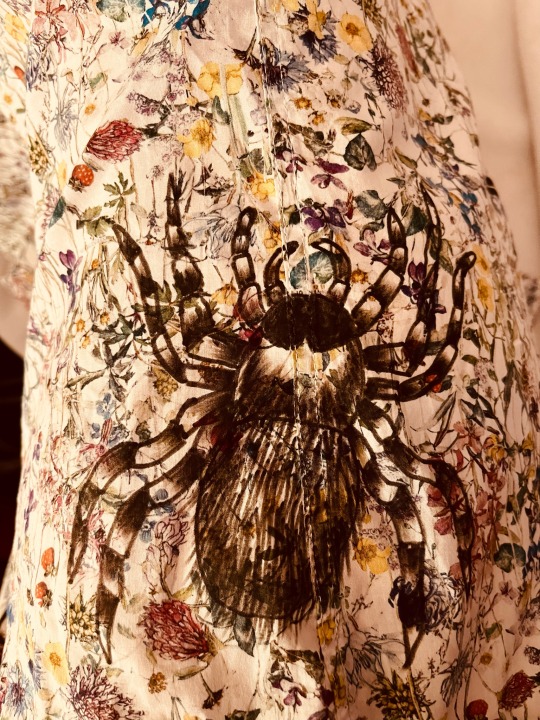
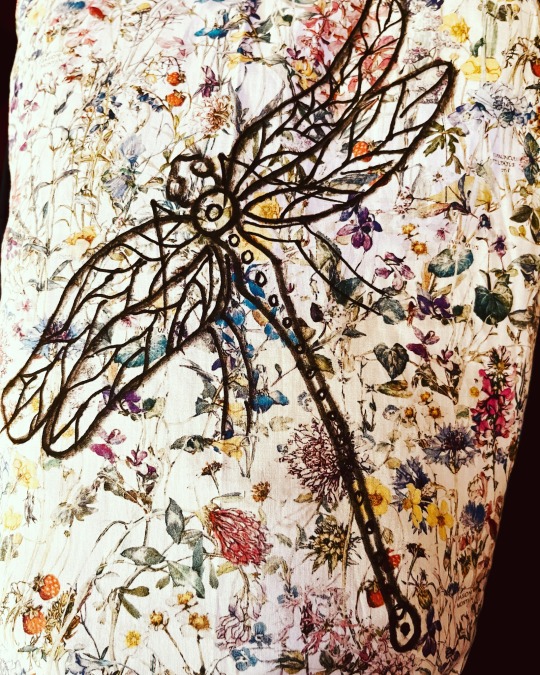
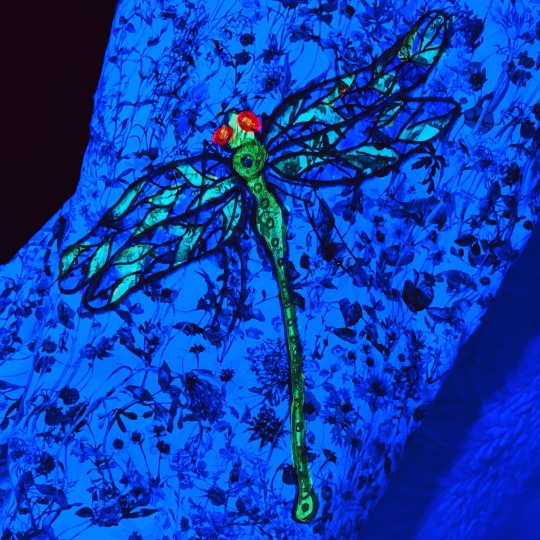

Little experiment drawn on floral print shirt insects and bugs a little romantic notion would have me hoping that Martin Margiela snd Alexander McQueen nit the bogus ones the real ones would give me 10/10 gif the effort and. Pat on the arse! Apologies for the Japanese ghost orchid looking so Tony I need to research more pens washable try hat can be fixed in white and grey scale
#martin margiela#alexander mcqueen#stephen chan lacey#artists#london#china#tokyo#paris#milan#new york#african american#music#essential#fashion#simple fashion#less is more#Bauhaus#style
4 notes
·
View notes
Text
Goth 101
🦇 tl;dr version for those who prefer that format
Goth is a music-based subculture that started out in the UK in the late 70s/early 80s and spread internationally from there. It spawned from the UK Punk scene, keeping the DIY ethics but turning the music more melancholic, introspective and experimental.
The music genres that the subculture was built around are (dark) Post-Punk, Gothic Rock, Darkwave, Ethereal Wave and a few other smaller subgenres.
While the fashion and other non-musical aesthetics are very prominent and beloved by goths, they're non-essential to the subculture. What defines a goth is the music we listen to.
Our "big 4" bands are The Cure, Sisters of Mercy, Bauhaus and the Banshees. However, 3 out of 4 of those bands are Post-Punk acts (Sisters of Mercy being the exception Gothic Rock band), and while very influential to the rest of the goth music scene, they by no means are the end-all, be-all of what goth music sounds like. The genre has evolved through its over 40 years of existence, creating diverse sounds. Anyone darkly inclined can find something to love, even if it takes a bit of research.
The Dark & Gothic playlist on Spotify is a pretty decent way to get started into goth music. In my old blog I had entire tags dedicated to goth music as a whole, and separately to Post-Punk, Gothic Rock, Darkwave and Ethereal Wave too. I had a few playlists based on popular goth aesthetics here.
The longer description of goth music will include playlists for each bigger goth subgenre, but please keep in mind they're made by me in a way that appeals to my personal tastes for each subgenre. I don't know every band that exists and my personal taste is biased towards the 90s.
Now, to a more detailed introduction to the goth subculture...
🦇 Dark alternative vs Goth
What a lot of people need clarified is that the goth subculture doesn't have a monopoly on the dark alternative world, nor are we the home for everyone sad, spooky and weird who doesn't fit in and might listen to any sort of sad, spooky or weird alternative music.
There are SO many dark alternative music scenes that have nothing or very little to do with the goth subculture. We've influenced a lot of them fashion-wise, but just because they copied us we look alike doesn't mean we're interchangeable.
There's no scale that goes from Prep to Goth and measures how Valid™ your inner darkness is, in which if you're anything below goth then you're a poser and lame. It's perfectly fine and cool to be dark alternative without being a goth. Goth isn't a badge of legitimacy or honor, it's just one specific flavor of dark alternative among so many.
Goth is a very small and obscure subculture despite our superficial hypervisbility (our looks and infamy are hypervisible, what we're actually about is extremely buried underground), and most dark alternative people aren't goths.
🦇 What does it take to be a goth?
There's one rule, and one rule only: LISTEN TO THE MUSIC. You wouldn't call yourself a metalhead without being a fan of Metal music, would you? The same principle applies to goth.
There are many types of alternative subcultures; some examples are fashion-based subcultures, another are lifestyle-based subcultures. A third type of subculture that's very prominent (especially in the West) are music-based subcultures.
Goth is a music-based subculture, just like the metalhead, punk, emo, rivethead/Industrial, hip-hop, rave, K-Pop and grunge subcultures are.
This means that, while the music isn't THE ONLY aspect the subculture has, in order to be a goth you have to listen to goth music, and we have a specific set of music genres that our subculture was built around, so not just anything dark and melancholy will do, as we don't have a monopoly on that, but we do have something closer to a monopoly on a specific sound and musical legacy.
You don't have to listen to goth music EXCLUSIVELY to be a goth, that'd be insane. You don't even have to limit yourself to dark alternative music either. You just have to listen to goth music to a relevant degree and be passionate about it and you're in, the rest is up to you.
This means too that the way you dress has no impact on your validity as a goth, whether you don't have the gothic wardrobe of your dreams yet or you just don't want to dress goth at all. I'm TikTok mutuals with a girl who dresses exclusively in pink-white sweet lolita coords, but who's passionate about goth music. She's a goth, no questions about it. On the other hand, a lot of the influencers you'll see online who look like a lost Addams cousin aren't goths at all, and no house decor or outfit will make them gothier if they don't listen to the music.
🦇 What music counts as goth?
From the previous points I made you probably gathered that Industrial and Metal – both genres that outsiders usually associate with the goth subculture – aren't actually part of the goth genre. So, what is goth music?
Goth music developed initially in the UK in the late 70s/early 80s off of dark Post-Punk. Post-Punk itself developed from UK 70s Punk Rock, being also influenced by Glam Rock, experimental electronic music, and many other influences more specific to each band that took part in this musical development (Bauhaus were very influenced by Reggae!).
What characterizes the goth sound are elements such as; being bass-driven rather than guitar-driven (in almost every case), guitars playing more of a decorative or atmospheric role instead of being the main focus (which contrasts starkly against genres such as Metal), preference for voices with a lower vocal range (altos, this is your genre to shine in!), optional use of synthesizers, recurrent replacing of human drummers with drum machines, and common use of lots of reverb and delay effects everywhere for an extra sensation that you're listening to music recorded in a catacomb.
Dark Post-Punk was the starting point of the goth subculture, and from it, all other goth music subgenres developed. Depending on who you ask there's a billion goth micro-genres. In my opinion a lot of those subgenres are rather meaningless (a lot of them are just specific flavors of Post-Punk or Darkwave) but the main 4 subgenres of goth music are:
(Dark) Post-Punk
Gothic Rock
Darkwave
Ethereal Wave
POST-PUNK:
Post-Punk took the standard sound of Punk Rock and its DIY ethics and made the sound more melancholic, romantic, experimental, less angry, and more introspective. Dark Post-Punk in particular was influenced by gothic literature and old horror movies (including their soundtracks, the Banshees created their characteristic guitar sound after the violins in the Psycho soundtrack).
Besides the 3 Post-Punk bands I listed as part of the goth "big 4", there's bands such as Skeletal Family, Twin Tribes, Specimen, She Wants Revenge, Sex Gang Children, Xmal Deutschland, Lebanon Hanover, Cruex Lies, The Secret French Postcards and The Birthday Party.
GOTHIC ROCK:
When goth became slightly more established in sound, Gothic Rock is what happened. Less experimental than Post-Punk, a bit more Rock-based, more decidedly dark and miserable than Post-Punk necessarily is, and finally severed from goth's punk roots. Sisters of Mercy is THE most popular and influential Gothic Rock band; they popularized the use of extremely low baritone vocals and drum machines. Despite existing since the 80s, its popularity peak was in the 90s.
Goth as a whole has its "big 4", but the subgenre of Gothic Rock has its own "big 3", which are Sisters of Mercy, The Mission (UK), and Fields of the Nephilim. Other Gothic Rock bands are Rosetta Stone, Corpus Delicti, Inkubus Sukkubus, Mephisto Walz, Angels of Liberty, Two Witches, Nosferatu, Wisborg and Soror Dolorosa.
DARKWAVE:
Goth going electronic! There's basically two types of Darkwave; the one that's more a combination of Post-Punk + Synthpop (very popular in the past decade), and the one that's more a combination of Gothic Rock + electronic music in general (most popular in the 90s). EXTREMELY danceable, but then again goths can dance to literally anything. This genre has existed at the very least since the second half of the 80s and has never stopped being relevant in the goth scene, save maybe during the Deathrock revival phase.
Clan of Xymox might be the single most influential Darkwave band. There's also The Frozen Autumn, The Crüxshadows, Switchblade Symphony, Collide, Dark, Ghosting, London After Midnight, She Past Away, Drab Majesty and Boy Harsher.
ETHEREAL WAVE:
This genre is heavily linked to Dream Pop, Neoclassical Darkwave and Shoegaze. Like with Darkwave there's basically a few styles of Ethereal Wave, I can pinpoint three; the one that's like, regular Goth Rock/Post-Punk but with a lot of extra delay and reverb and other stylistic choices that make it sound, well, Ethereal, dream-like. There's the type that has lots of Folk influences (be it Medieval/Rennaisance-ish type of Folk or "ethnic" type of Folk), and there's one that's synth-based but, unlike Darkwave, sounds like what ketamine must feel like. This genre has existed since the mid 80s but its peak in popularity and relevancy in the scene was in the 90s.
Dead Can Dance is THE most influential Ethereal Wave band, but there's others such as Cocteau Twins (started as Post-Punk, ended up as Dream Pop and Ethereal Wave), Miranda Sex Garden, Faith and the Muse, Lycia, Claire Voyant, Hamsas XIII, Love is Colder than Death, SRSQ, Black Tape for a Blue Girl and Mors Syphilitica.
What about Deathrock, Gothic Metal and Industrial?
Deathrock is goth's American twin, basically. While in the early 80s in the UK morose ex-punks were playing Post-Punk, in the early 80s in the LA Punk scene morbid and brooding punk kids were playing Deathrock; it's closer to Punk Rock in sound than Post-Punk, being more about being spooky and brooding than about being eerie and romantic. Goth is to vampires and witches what Deathrock is to zombies and werewolves.
To summarize the consensus on Deathrock and its place within the goth subculture; it's rare to find a goth who's not also into at least some Deathrock, and even rarer to find a deathrocker who's not into goth. Personally, I think Deathrock is its own separate though very similar thing, but I don't mind Deathrock being lumped in with goth music.
I made a whole TikTok video on why Gothic Metal isn't a goth subgenre, but in summary; Gothic Metal is a Metal subgenre that was somewhat influenced by goth music in its earliest stage of development, but is for the most part a cross between Doom Metal and Death Metal with lyrics inspired by gothic literature. By adhering to a Metal sound it doesn't fit the type of sound goth music has. The goth influences in Gothic Metal were mostly only present in the earliest bands and a majority of the newer acts are completely disconnected from the goth scene.
As for goth's ties to the rivethead subculture (and thus, Industrial music): We've been sibling subcultures since at least the early 90s. Both very, very small and underground scenes that despite being different, had enough similarities in music, idiosyncrasy and aesthetic sensibilities to comfortably band together for the sake of scene viability. That's why you might hear people talking about the "gothic-industrial scene".
Keep in mind too that 80s and 90s Industrial music sounded very different from how it does now (compare your average Grendel or Combichrist song to your average Skinny Puppy or Die Form song). There was a lot less influence of raver music in the rivethead scene back then, and a lot more influence from 80s dark alternative music and New Wave, which are key influences for the goth scene as well.
As told by goth YouTuber Angela Benedict (goth since 1995), every goth back then listened to at least some Industrial, every rivethead listened to at least some goth music, and they all loved 80s New Wave, so DJs at shared club nights had a very easy time entertaining both audiences simultaneously.
🦇 Trivia & other things to know
The term "gothic Rock" was being used in music journalism as early as to describe releases by The Doors and The Velvet Underground, but the word "gothic" there wasn't so much used to point to a specific type of sound at that stage, it was used to imply the mood of the music and that's not where the subculture gets its name.
We don't know for sure why this subculture began to be referred to as "goth", initially the music was called either New Wave (just a darker and more underground variety of it) or Positive Punk. However, one of the potential roots of this name for our subculture is that it comes from an inside joke from members of Southern Death Cult/The Cult about Andi Sexgang (Sex Gang Children) about how he was a creepy little guy obsessed with the macabre and dark romanticism living at the Visigoth Towers, so they called him a "goth goblin" and if he was a goth, then his fans were goths too.
From the comments that the goth bloggers/vloggers I follow get, apparently it's common for baby bats and people interested in the subculture to think that they HAVE to find a goth "type" to lock themselves into, like "trad goth" or "romantic goth" or whatever else, and if they don't, they're a poser. This isn't true at all. Most goths wax and wane between fashion styles and goth music subgenres. These terms are far more useful to describe aesthetics rather than people or music.
If you ever hear people talk about "1st/2nd/3rd wave goth/Gothic Rock"; that's an (in my opinion) outdated and not too functional terminology to differentiate between "eras" of goth music, 1st wave being between 1975-1985, 2nd between 1985-1995, and 3rd between 1995-? That terminology was used widely when I was a baby bat but not so much anymore.
"Baby bat" is what a lot of more established goths call newbies! It's NOT meant as an insult nor to be condescending. It's a loving cutesy term and while of course most baby bats are very young, it's perfectly plausible to be a very grown adult and a baby bat if they just got into goth instead of getting into the subculture as a teen.
Most goth bands are easily found on Spotify except for more underground ones that haven't been active for a while (I have so many beloved bands and songs that just don't exist on Spotify), but the real goth jackpot is at Bandcamp.
Facebook is still useful for one (1) thing and it's for finding goth events; that's where I've found out about gothic fairs, goth nights and gigs; from the largely popular ones in my local scene to the very underground ones.
The song most of the subculture agrees is THE first official goth song is Bela Lugosi's Dead by Bauhaus, which was recorded as a singular take. It was the first track the band recorded together, too.
The Batcave is infamous nowadays as a huge goth night club in Soho (London) during the early 80s, owned by the band Specimen, BUT as told by the very people who used to frequent the nightclub, the whole thing has been a little overblown and its current reputation is more legend than fact. YouTuber Gothcast has a great video on the subject that was praised by members of Specimen itself!
youtube
Most of the most iconic pioneer goth musicians HATE being referred to as goths or to have their music referred to as such. When the term "goth" was first starting to be used to describe our music and scene it was a pejorative used by outsiders and/or mostly associated with the campier and more "low brow" bands (Specimen and Alien Sex Fiend come to mind). Andrew Eldritch from Sisters of Mercy especially hates it, to the point he refuses to even say the word and refers to it as "the G word". Which is hilarious since he sounded the most stereotypically gothy out of the big 4 and looked like this at the time he started to be a piss baby about it:
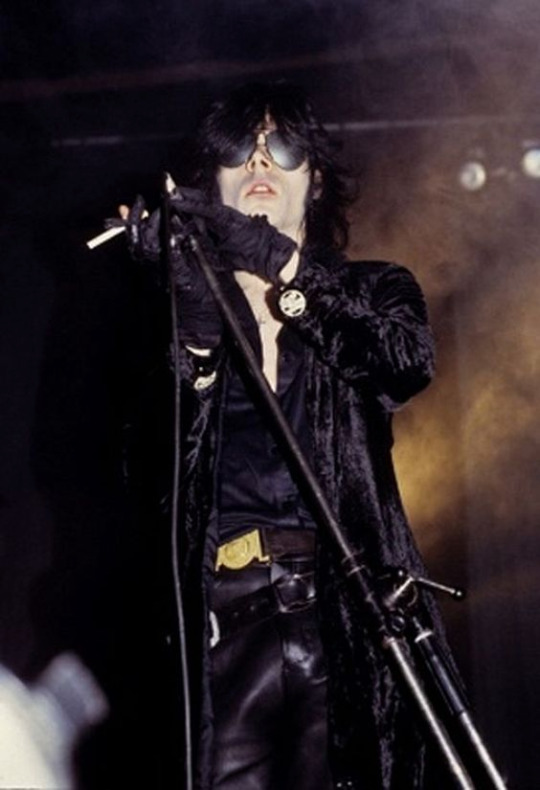
Goth isn't really a "youth" subculture anymore if you ask people within the scene. Unlike people from many other subcultures, goths have a tendency to stay goth far into adulthood (even if covertly). When you go to any events, besides teens and people in their early 20s, you're gonna see plenty of goths in their 40s and older, a few of them will bring their kids along if the event is family friendly.
Besides the obvious chance of many goths being professional creatives (musicians, writers, artists, etc), for some reason A LOT of goths work in tech and healthcare!
Metalheads headbang, they and punks also mosh. What do goths do to vibe to our music together? We dance! We don't dance the same as non-goths but we LOVE to dance to our music, together or solo. There's no established dance styles to adhere to; it's just letting your body flow to the music. Some goth dancing is very intricate, some of it is very simple, it depends on the goth in question. Just in case, this is NOT like the dance gifs of cybergoths/rivetheads under that damned bridge. Think less that and more Wednesday Addams dancing to The Cramps, or the girl from the Night of the Demons movie. Here's some videos about how goths dance:
youtube
youtube
youtube
We fucking love 80s New Wave. No, Depeche Mode isn't a goth band; yes, you'll have to dig deep to find a goth who doesn't ADORE them. The only one I've come across who disliked Depeche Mode liked Soft Cell instead.
Goth IS international! Not just in the sense that there's fans of goth music basically everywhere, but that there's local goth scenes with their own local goth bands everywhere. Outside of the US + Europe + Canada, there's huge goth scenes all over Latin América (our Deathrock and Post-Punk are at times even popular among 1st world goths), and there's also smaller but still present goth scenes in Africa, Asia and Oceania. She Past Away is very much one of THE most popular goth bands in recent years and they're from Turkey.
The goth scene has always been in friendly terms with the LGBT community. Not only are many of our biggest icons LGBT themselves (the whole band Specimen, AVC from Sopor Aeternus, both members of Diavol Strâin, the vocalist from Male Tears, Cinnamon Hadley, and many more) but plenty of cishet goths (especially the men) embrace gender non-conformity and/or androgyny. In most local scenes, goth club nights are held at gay bars/nightclubs, as they don't tend to have privately owned venues. And either way, at any goth night there'll be tons of gay and gender non-conforming goths no matter where they're held. To varying degrees depending on the locality of the scene, gay and bi people are completely normalized in the goth subculture, and gender non-conformity and androgyny aren't just encouraged, but praised and coveted.
There's goths of any religion you can think of, but Neo Pagans are somewhat over-represented in our community compared to the rest of larger society (for better or worse). Funnily enough, very few goths are actually Satanists of any sort. I'd say the numbers go more or less similar to our local non-goth peers. In the West and westernized countries I'd say it goes; majority culturally-Christian atheist or agnostic goths (usually not militant about it), a few practicing Christians of whichever denomination (usually whichever is dominant in the country they inhabit), the rare but entirely plausible Jewish, Muslim or Buddhist goth, and a bunch of Neo-Pagans. Probably one (1) or two (2) actual Satanist goths per state/province/etc, tops.
World Goth Day is celebrated every year on May 22nd.
"Mallgoth" isn't a type of goth in either a musical or fashion sense. I made another TikTok about it, but in summary; it was originally hurled as an insult towards a very specific type of poser; the American kids in the late 90s and early 00s who imitated how goths dressed and called themselves goths while only listening to Nu Metal and maybe the most mainstream Industrial Metal. They tended to congregate at malls and behave particularly obnoxious to everyone there, further ruining our already delicate image (especially at that time).
Cybergoths aren't really goths either. Their music scene is centered around EBM, which is basically slightly darker and slightly more aggressive raver music that may or may not have Industrial influences. And to be honest they behaved like a rapacious invasive species in goth club nights to the point that they almost decimated the actual goth scene and it took us a while to recover from that.
Goths are sometimes perceived as too self-serious but honestly? We love making fun of ourselves and we tend to have a very silly or dry sense of humor. We're just tired of the same cheap and inaccurate jokes made by people who don't know anything about us. The best jokes about goths will often come from goths ourselves; you can only properly make fun of something you understand well! The few times outsiders get it right though? (Sad to confirm that the South Park goth kids are hilarious and I wish they were in a better show) You'll see goths sharing the SHIT out of it, such as me being obsessed with the goths from Ridonculous Race, or the clip below:
youtube
#goth music#music#goth#gothic#gothgoth#goth subculture#trad goth#gothic rock#post punk#darkwave#ethereal wave#Spotify#goth 101
1K notes
·
View notes
Text
100 hours of POST PUNK
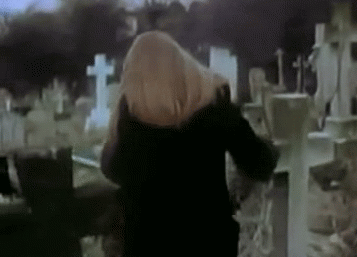
All eras (76, 1980s, post punk revival, post punk 2k)
All subgenres (no wave , the new wave, doomer, some shoegaze, dance punk , garage rock revival )
All Regions (Mex🇲🇽) (RUS🇷🇺) (UK🇬🇧🏴🇮🇪🏴) (USA🇺🇸) (Den🇩🇰) (SWE🇸🇪)
Includes Interpol, Talking Heads, Lowlife UK, Joy Division, molchat doma, ,Iceage, Fontaines DC, Shame, Squid, Ploho, The Horrors, Bitchevsky Park, Bambara, A Projection, Protomartyr, makthaverskan , The Feelies, New Order, The Mission, Preoccupations, Black Midi, Editors, White Lies, The Strokes, KILLING JOKE, king krule, The National, Two Door Cinema Club, The Fall, Bauhaus , Nick Cave, Essential Logic, ESG, Viagra Boys and More !
#shame band#fontaines d.c.#squid band#black midi#ice age#Bambara#there is a light that never goes out#love will tear us apart#see no evil#television#marquee moon#gang of four#the horrors#spotify#alternative rock#dark music#goth#goth punk#joy division#goth girl#gothic#killing joke#goth gf#spotify wrap 2023#spotify wrapped#spotify playlist#2023 playlist#new playlist#playlist of the week#idles band
169 notes
·
View notes
Text

Anni Albers - Variation on a Theme - 1958 - Abstract Textile Art

Anni Albers in her weaving studio at Black Mountain College in 1937.Credit…Helen M. Post, via Western Regional Archives, State Archives of North Carolina
LONDON — When Anni Albers was 91, she received an honorary doctorate from the Royal College of Art here in 1990. A ceremony was held nearby at The Royal Albert Hall, so solemn that a friend of hers joked that the venue deserved to be renamed “The ‘Royal Albers Hall.”
Ms. Albers attended the festivities in a wheelchair and accompanied by a nurse, but the textile artist stayed through the three-hour ceremony and collected her award for a lifetime of achievement.
As she was being wheeled out of the hall after the ceremony, Nicholas Fox Weber — the executive director of the Josef and Anni Albers Foundation in Bethany, Conn., and who recounted the episode — asked her how she felt.
“Those were the most boring three hours I ever spent,” came Ms. Albers’s deadpan reply.
“Anni shot straight about everything,” Mr. Weber said in an interview. “She was focused, independent — a brilliant artist and totally funny.”

Anni Albers - Red & Blue Layers

Anni Albers - South of the Border, woven cotton and wool, 1958.

Anni Albers - "Intersecting" - 1962
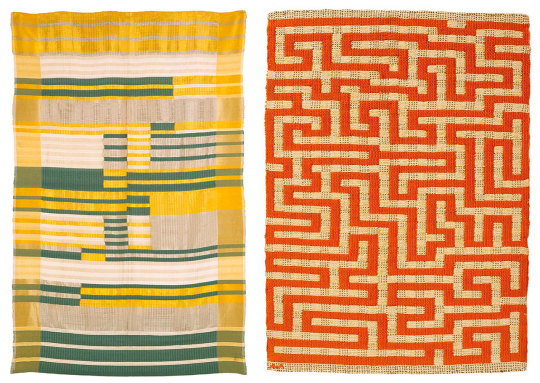
At the Bauhaus, where women’s choices for study were limited, the aspiring artist ended up in the weaving workshop. “I heard PAUL KLEE speak, and he said to take a line for a walk, and I thought, ‘I will take thread everywhere I can,’ ” she once told Nicholas Fox Weber, executive director of the Albers Foundation.
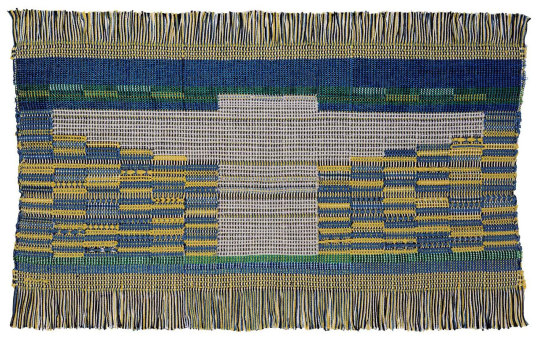
“She was very cerebral,” says Danilowitz, who knew the artist personally, “and weaving is very technical. It’s a lot like engineering, so it was a natural fit for her.” The Bilbao exhibition includes several of her black-and-white mathematical grid diagrams for weavings, including checkerboards in various scales and houndstooth-like patterns.
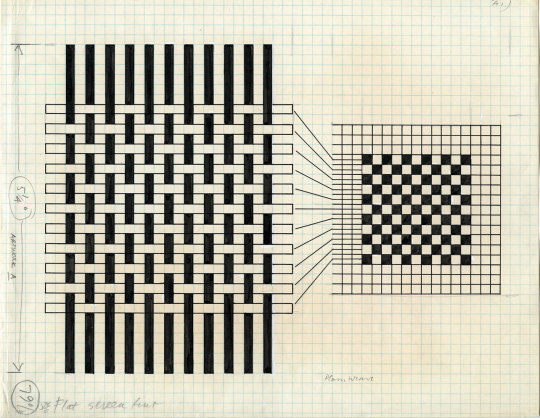
At the Bauhaus, Anni met and married fellow student JOSEF ALBERS, who would later become a celebrated color theorist and painter. His “Homage to the Square” paintings, which explored the relationships between colors, are now considered modernist masterpieces, and his 1963 book Interaction of Color is an essential text on color theory. After graduating in 1930, Anni and Josef both became teachers at the Bauhaus, but when the Nazis came to power, the school was shut down. In 1933, fleeing the Nazis, the couple emigrated to the U.S., where they both became teachers at Black Mountain College, in North Carolina.

Anni Albers - “Red Lines on Blue” - 1979, Rug designed for Modern Masters Tapestries
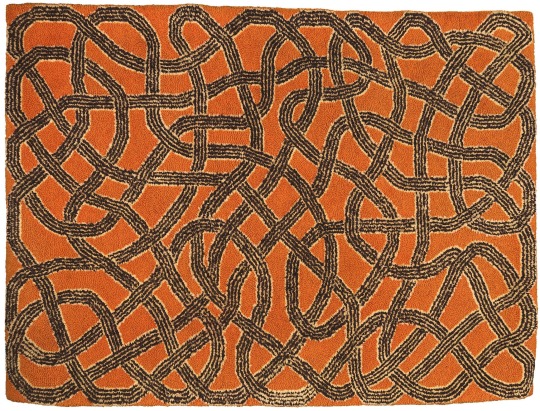
Anni Albers -Rug - 1959
159 notes
·
View notes
Text
The women of the Bauhaus: often unrecognized masters of modernism. Their contributions to design, art and architecture were essential to the movement. It's time to celebrate these pioneers and honor their legacy.
#bauhaus weavers#bauhaus#bauhaus movement#design#art#bauhaus masters#gunta stölzl#anni albers#marianne brandt
128 notes
·
View notes
Text
In 1937, urban planners debated turning Tel Aviv into a ‘Riviera city’ in a proposal called the Grunblatt scheme, which is reminiscent of Le Corbusier’s unrealised 1933 Plan Obus to demolish the Cape of Algiers and construct an elevated highway along its coastline. Today, many of the Palestinian beaches belong to private developers and hotels. This is part of a longstanding policy of effacement, whereby Palestinian scenes of dispossession become sites of Zionist leisure. After the massacre of residents in al-Tantura (occupied May 22–23, 1948; population of 1,500) in 1948, the Palestinian population was driven out. A mass grave of several dozen bodies remains, and today it lies under the parking lot of Dor beach, near Haifa. These processes are not unique to Palestine, architecture and redevelopment play essential roles in the construction of a revisionist urban coloniality. Both Tel Aviv and Algiers were given the moniker ‘White City’.
But Tel Aviv is not particularly white. Off-white maybe, mostly grey. Sharon Rotbard’s WHITE CITY, BLACK CITY (2015) examines the Bauhaus style that is the city’s pride. The Ashkenazi elite of Tel Aviv sought refuge in the ‘values of order and rationality’, she explains, against ‘the amorphous black chaos’ of the present. ‘It enabled many Tel Avivians to conduct wealthy bourgeois lifestyles, and at the same time to expose a socialist and progressive façade, to take solace in the assurance that while their city was clearly grey and faded, it was actually white and clean; that although it was no more than a provincial Western outpost, it was as international as the International Style; and that although it was modern, it was historic.’
The early essays about the local International Style in HA’IR and HA’ARETZ newspapers praised it as neither historic nor revolutionary, but as a sensible innovation, emphasising ‘usability, economy, modesty, cleanliness’. Tel Aviv’s Bauhaus represents the aestheticisation of sterility, which was the style’s original function, in a clear through line from the sanatorium that helped to popularise it. The export of this architecture to the colonies held the promise of ridding the cities of their distinct character, of curing the tropics of their diseases.
These architectures, then, reinforce a psychogeography of ‘cleanliness’. In light of the increasing visibility and political power of the messianic-Zionist bloc in the Israeli governing coalition (Benjamin Netanyahu’s Likud alongside the Hasidic political parties United Torah Judaism and Shas), the re-emphasis of Tel Aviv’s White City’s heritage serves as a coping strategy of sorts for Tel Aviv’s settlers in particular. It allows them to self-narrate as ‘liberal’ and to separate themselves from an unwashed ‘Other Israel’, supporting the story that Tel Aviv’s relationship to the rest of the state is of a cosmopolitan vestigial organ. This is romantic, but untrue. While the fanatical settler foot soldiers that roam the frontier are perhaps the most visible parts of the Israeli project, a quieter enemy remains at work – the state’s bureaucratic violences, dressed as system planners and administrators. Tel Aviv’s ghouls in their windowless offices stare at population registries of Palestinians, a blinking red button in front of them, adding to their press releases a Biblical or archaeological citation to camouflage the ethnic cleansing.
152 notes
·
View notes
Note
can you tell me the difference between emo and Goth?is punk not the same as goth? I am really confused...How do you tell the difference?
I did not mean this in a hostile way, just confused...
no no babe ur not hostile at all!
emo, punk, and goth are all different subcultures with distinct roots and music. punk, of course, came first, and from that post-punk as a genre was born. punk was a counter-culture youth movement in the 70s that started in England and gave rise to a new type of music, with less emphasis on musicality and more on boundary-pushing and messaging. Punk was very much anti-establishment. post-punk and goth are essentially the same genre. goth as we know it today is known for its dark aesthetic, but it very much came about because of the late 70s music scene. The Batcave in London was the popular venue at the time and early goths were called bat-cavers. bands from this era are Bauhaus, Siouxsie and the Banshees, Specimen, Sisters of Mercy, etc. Very cool stuff!
Emo has its roots in the 2000s and is sort of born from goth, but they diverge heavily. aesthetics can intersect to a small degree but emo music sounds very different from goth. I’m pretty sure (I’m open to corrections I’m not emo myself) that emo encompasses a lot of pop punk and similar genres. A good rule of thumb is that the Sex Pistols are punk, SATB is goth, and MCR is emo
25 notes
·
View notes
Text
Solarpunk is people! - notes on a generic visual identity
If you’ve been searching for solarpunk content online, you might have run across a recent video by YouTube creator DamiLee called “Solarpunk Cities: Our Last Hope?” DamiLee’s channel (from what I understand) is focused on architecture and urban design, and she’s often covered the aesthetic / urban design of various science fiction cities. It’s fascinating; would recommend!
This particular video contrasts solarpunk and cyberpunk from an architectural standpoint, and she makes the very incisive observation that while cyberpunk’s emphasis on Brutalist design gives it a cohesive identity (i.e., you look at the buildings in any snapshot from Blade Runner and you instantly know that this is a cyberpunk film, even if you don’t know the plot), solarpunk doesn’t really have that. And that’s a problem.
According to DamiLee, this “lack of a common architectural language in solarpunk,” though it might seem to be a small non-issue, is a bigger problem than you may think, as a cohesive architectural style often “serves as the glue that binds social movements or a cultural ethos.” She gives a very compelling example in the post-WW1 Bauhaus movement in art and architecture in Europe, but I want to explore this point about solarpunk a bit more. Because I think the issue is tangled in the very ethos and values espoused by these movements.
In cyberpunk, the city stands in for the government and its dictates. We don’t meet the architects of the skyscraping office towers of the corporations, the brutalist buildings the protagonists walk through, or even the streets or broken geodesic domes* that the proletariat must live in.
There is no individual or community control over urban design in cyberpunk, or none that we’re shown, in any case.** There’s a sense that the individuals are helpless against the powers that be, which is kind of the point: cyberpunk is all about the little guy fighting back against the (mostly) faceless oppressive evil forces that have most of society under their bootheel. It makes sense that the buildings are all cookie-cutter concrete, because it really doesn’t matter if this plot takes place in alternate Minnesota or alternate Moscow; the place is irrelevant, the environment inconsequential, the culture basically erased by imperial corporate imposition.
Solarpunk architecture, on the other hand, embodies the ethos of solarpunk: the valuing of community input, responsive to individuals’ needs and differences, sensitivity to the differing eco-regions and environments across the world, and - to boil it down to a very bare essential - the valuing of people (human and non-human alike), culture, and planet.
I personally think it would be impossible, in that case, for solarpunk architecture to have a cohesive style. Instead, I think what to me makes an aesthetic solarpunk is not a specific type of building or street, but the inclusion of people in those images.
To me, cyberpunk-style Brutalism gives off the sense that the buildings are not built for people, per se, but to fulfill a design dictat or quota regardless of function. The people adapt to the architecture.
In my ideal vision of solarpunk design, the architecture adapts to the people. The values and ethos of the movement shapes the city: the design is responsive to people and place, because the people are empowered to make changes to their dwellings and the architects and builders have faces and names and contact information and the environment is taken into consideration when choosing building materials, et cetera.
Right now in the solarpunk present, I think that realistically people are going to have to adapt to whatever we’re given instead of the other way around. But I also think that it’s worth holding the vision of this solarpunk future city that is informed by responsive design and transparency in the architectural and urban planning processes so that we don’t fall into the trap of thinking that since city design is decided on by (a vague sort of idea of) other people, we must just make do with what we are given, as that’s the way it always has been and always will be.
I believe that we can get to a solarpunk future where our cities are intentionally designed to be functional, beautiful, responsive, sustainable, and ultimately a great place to live, instead of just the places that people have to live.
On that note, I think the idea of manufacturing the ideal solarpunk city for New York, then replicating it to plop into Jakarta, or Iqaluit, or Nome, or Mexico City, or Addis Ababa is not only ridiculous, but goes against the ethos of solarpunk itself. The idea of a singular design that works in every bioregion is unrealistic to me (though I do not hold an architecture degree, and am happy to be wrong, but as someone who lives in a place where it gets pretty cold for half the year, the idea of gaily implementing [for example] earthships (tm) without regard for or significant adaptation to the climate is ridiculous to me).
The cohesive design of solarpunk is its variety and its people, and its ability to adapt and change as necessary to the realities of life in the present, in order to intentionally work towards a better future.
——
*I see you, Johnny Mnemonic.
**Although if you have an example I’d love to see it!
13 notes
·
View notes
Photo

Alvar Aalto
#alvar aalto#armchair#scandanavian#scandinavian style#bauhaus design#bauhaus essentials#bauhaus movement#bauhaus furniture#furniture design
171 notes
·
View notes
Photo

Jean Prouve and stuff
#jean prouve#galerie patrick seguin#me#fhuzee#hommedessept#parisian fashion#parisian style#parisian vibe#essential homme#muji#jumpsuit#basket boy#Bauhaus chairs#Charlotte Perriand
4 notes
·
View notes
Note
hello, i noticed you have "elder goth" written in your bio and im like. an infant bat. do you have any tips on anything (music, makeup, clothing, ect?
(srry if this sounds awkward, im just a very nervous person)

Whew! I DIDN'T FORGET YOU!!! It was an INSANE weekend at work...and I'm burnt. Plus, I like to write my fics and answer asks at my desktop computer and not my phone (fat fingers are clumsy).
Ahem...ok for the Goth Thing:
It's really just about the music. That's it. I mean SO MUCH has evolved and developed since the first wave of that "genre" music appeared on the scene back in the 1970's (Post Punk) underground. Even some bands labeled as Goth now didn't see themselves as such back in the day.
This next list has a lot of good Goth music, with some songs not necessarily in that genre, but close enough that MANY in the community love them. And, some of them showed up before the movement even started (a few after to help with it's evolution), but definitely helped to establish the genre later on (ahem...David Bowie). Btw Marilyn Manson is NOT Goth. However, a LOT of us still love his music as it fits with our dark aesthetic...and remember when I mentioned David Bowie? Well, I am quite sure he helped inspired Marilyn Manson. His Mechanical Animals album certainly looks as it was influenced by Bowie. But, I digress, again... This is just a start on your musical journey...a stepping stone.
People will tell you that if you don't dress or present physically a certain way that you aren't Goth. NOPE. You can dress dark and spooky and edgy but not be Goth. You can dress like a pink princess or "normie" and be Goth at heart. When us older Children of the Night were coming up we did a LOT of DIY (do it yourself) and wore a lot of things you might not consider even Goth. There wasn't the depth, breadth, and easy access of things available on the market like today. We were poor, felt different, non conformist, and just looking for community. That's another hallmark of being a Goth: community. Because back in the day someone might do a violence on you for looking weird (Wearing all black back in the day was seen as extremely socially deviant. ESPECIALLY in small town US or conservative UK/England. People literally were afraid of or hated us. Our brethren: The Punks, Rastafarians, Metal Heads, Rappers, New Wavers (prejudice was doubled if you were a person of color, a different sexuality/gender, poor, etc.) experienced the same thing in society. Then came along The Satanic Panic and OH SHIT what a pain in the ass that was! And The "Moral" Majority crap...) I digress: we were looking for people like us, BUT THEY DIDN'T HAVE TO LOOK EXACTLY LIKE US. Just a bunch of nice, supportive people who got together to listen to music, dance, support the local bands/talent, and try to make it another day. You will find this in the FANDOM, LGBTQ+, and Communities of Color as well...and they overlap.
The presentation is secondary and up to you on how you want to look. You can do it up the max or just be simple in black. My favorite person from back in the day, who really doesn't specifically identify as Goth, but hung heavily in the scene back in the day: Neil Gaiman. The guy who gave us the character of Death from The Sandman Series, published as I was coming into my own Baby Bat phase (based on a real person named "Cinnamon"). Yeah...the character everyone aspires to look like (next to Siouxsie Sioux). He wears just plain black clothes and a long black coat. (Pic of him as a youngin')

Me, I go for "Lazy Goth". Everything black (even at work-black scrubs) with occasionally printed tee or a dark jewel toned piece of clothing. Usually I also mix in the Punk aesthetic too (I love the music and put patches on every damned thing). Punk is scruffy and imperfect, not fussy. I like comfort and ease of dressing. Especially in hot weather. And, I don't do a lot of face makeup, especially being older. Plus, I rather like my olive toned skin. Not every Goth needs to be pale. Google Goth People of Color. Beautiful and amazing looks.
Beware of Gatekeepers. Gothier Than Thou's. Don't let them crush your spirit. There is room in this subculture for everyone. If a particular club, group, or individual sets that tone, just move on. That shit ain't worth it.
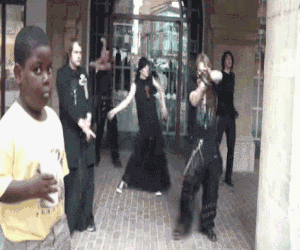
Dropping a quote from my (sort of) GothFather creative Neil Gaiman:
"Go and make interesting mistakes, make amazing mistakes, make glorious and fantastic mistakes. Break rules. Leave the world more interesting for your being here. Make. Good. Art."
This can also be read as the journey to "create" yourself. You are on a journey, my sweet Child of the Night. It will take a while to find your stride, whatever that is, and that's totally ok. Spread your bat wings and FLY!
Leaving you with one of my favorite songs:
youtube
7 notes
·
View notes
Text


Test designs for some new guys!
First one is Yellow Platanera, he's a Texas Wasp Moth. He's a rockabilly star who's very popular in the fruitbugs desert level. He's no stranger to getting close with his fans- it's actually because deep down he doesn't feel like he deserves good things. He feels that way because people compare him- despite being in a different genre of music- to Pricklypear Glowkids, and Platanera feels like he'll never be as good as the former.
Second and third of the first pic are the same person, pre and post transition: his name is Quadrat Wassermelone, and he's a Hollow Twig Spider. He's a real estate guy that builds bauhaus-like houses, but thing is that they're also non-euclidian endless labyrinths. He also makes people trapped in them pay rent. But guys it's ok he's trans and happy now dont worry about it
Third is Hawthorn Wildflower and he's a Common Cricket. He's essentially feral but also a knight. He lives in a wild meadow full of wild flora you don't find anywhere else, and protects it from anything and anyone that threatening. He made his sword himself and can't talk so well but like most fruitbugs he's romanceable. He's pretty spontaneous and impulsive in behavior.
Last one is Rosehip Valiantheart- and he's a White Plume Moth. Dont be fooled by his given name, he's actually a bad guy! Rosehip hunts who or what ever is the strongest foe in a given level/area and battles it to the death. His reasons for that behavior are a very skewed sense of 'justice', that actually is more a selfish thrill. He was once a noble knight, but something happened that broke him and turned him into a relentless, violent shell of a man. He doesn't have any mask or armor- what you see is his actual face and exoskeleton! His facial cavity can have an inhumanly long tongue come out of it, if you ever get lucky enough to 1) be spared by him 2) make him trust you and 3) take him in an ice cream date or something (which is entirely doable. Hard but doable).
#o#rose'socs#fruitbugs#fruitbugs yellow platanera#fruitbugs quadrat wassermelone#fruitbugs hawthorn wildflower#actually all 4 of them are trans men. Just Quadrat has a pre transition self#if you think that's too much: theres' a reason for this#you see the in-universe fruitbugs creator- Kraton- is cis and straight. He makes mostly male characters to appeal to fans#but he also tries to 'even it out' by creating female characters too. But thing is.#Every single one of them dislike the way they're programmed and transitions into a man. Kraton is aware of this ad tries to 'fix' it#by editing his character's programming or by deleting the character and recreate it from scratch#but. They still choose to transition every single time. The reasons aren't always the exact same but the result is.#so Kraton just gives up. and lets his sentient trans characters exist#rosehip has a pretty obvious insp i think but look. No one ever listened to me when i said he was trans#despite having an alternate palette that literally has the trans flag colors on it. But now im evil and he's an oc so he's trans for real!!#quadrat has also an obvious insp but: early internet clip art of Him was too good i had to make an oc sorry#fruitbugs rosehip
12 notes
·
View notes